Table I Classification of Radioactive Wastes Produced from
Radioisotope Users
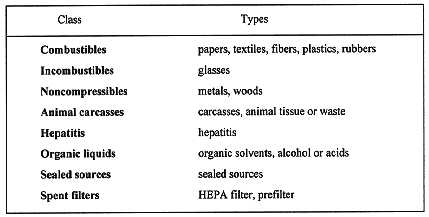
Table II Status of Radioactive Wastes Produced from Radiosiotope
Users
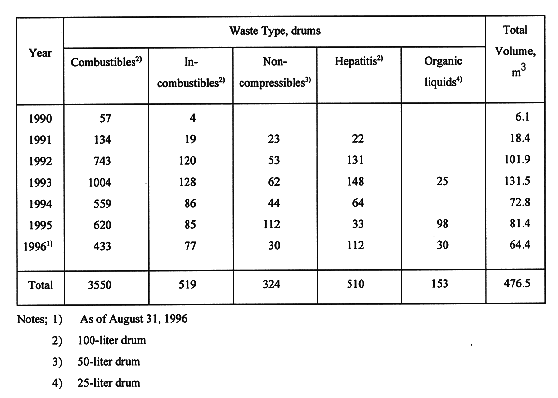
Jeong-Guk Kim, Hee-Chul Yang, In-Tae Kim, and Joon-Hyung Kim
Korea Atomic Energy Research Institute
P.O. Box 105, Taejon Yusong, Taejon,
Korea 305-600
Min Baek
Radiation Safety Division, Ministry of Science
and Technology
1, Jungangdong, Kwachon, Kyunggi, Korea 427-760
ABSTRACT
The low level wastes produced from radioisotope users were incinerated in a demonstration-scale incineration process to study the behavior of radionuclides. These wastes have been collected from radioisotope users by Korea Radioisotopes Association, and stored in Korea Atomic Energy Research Institute, however, this management system will be changed sooner or later. The major nuclides in these wastes were iodine-125 and technetium-99m. The trial incineration of the combustible wastes that had passed more than 2 years since generation resulted in volume and weight reduction factors of 250 and 30, respectively, with no detectable radioactivity at stack emission. A simulated waste with a I131 labeled sodium iodide of 74 MBq was also incinerated. The specific activities of ashes from the baghouse filter system and afterburning chamber were 370 and 24 times as high as that of incinerator bottom ash, which shows that a major portion of radioiodine melts or vaporizes at incineration temperature and gets away from the incineration chamber, then condenses while passing through the subsequent off-gas treatment system. The decontamination factor of this incineration process for iodine-131 nuclide, defined as the ratio of the radioactivity of the feed waste to the radioactivity released at stack, was an order of 105.
INTRODUCTION
With an increase in use of radioisotopes, safe management of radioactive wastes produced by radioisotope users (RI wastes) has become a great concern in public health and environmental preservation (1-3). Because these wastes come mainly from activities involving trace amounts of radioactive nuclides in biological, medical, and research programs, they usually have only very low concentrations of radioactive nuclides, that is, they are a kind of "contaminated waste (4)." In spite of their low activity, these RI wastes have been treated carefully because of the potential risk.
Korea began to manage the RI wastes under the control of the government in 1990. Up to now, Korea Radioisotopes Association (KRIA) has collected the radioactive wastes from radioisotope users and transported them to a storage building in Korea Atomic Energy Research Institute (KAERI). According to a recent change in radioactive waste management policy, however, Korea Electric Power Corporation (KEPCO) will manage the radioactive wastes including RI wastes.
RI wastes are categorized, depending on their characteristics, as combustibles, incombustibles, noncompressibles, hepatitis, organic liquids, animal carcasses, sealed sources, or spent filters, as listed in Table I. Animal carcasses have not been collected yet because of rotting in transportation and storage. Organic liquids and sealed sources are packed in stainless steel 25 liter drums. Noncompressible wastes and the other wastes are packed in carbon steel drum of 50 liters and 100 liters, respectively. A total of 5,056 drums, equivalent to 476.5 cubic meters, except for animal carcass, sealed source and spent filter, were stored in an interim-storage building of KAERI, as of August 31, 1996, and summarized in TABLE II.
Table I Classification of Radioactive Wastes Produced from
Radioisotope Users

Table II Status of Radioactive Wastes Produced from Radiosiotope
Users

Recently, extremely low level wastes have been allowed to be treated and disposed of just as non-radioactive waste to reduce the amount of the government-controlled radioactive waste and lighten the expense in treatment of RI waste (5). Such an exemption limit for RI wastes is 100 Bq/g (2.7 nCi/g). This on-site management/disposal has been performed by incineration for combustible waste from medical and institutional facilities (6).
Now, KAERI is working to get a license for a demonstration-scale incinerator (Fig. 1) as an on-site treatment facility of the low level wastes (LLW), and will operate it from the first half of 1997. Using this incineration process, as described in a previous paper (7), the trial burns of non-radioactive simulated wastes (8,9), simulated wastes containing hazardous and radioactive metal compounds (10) and radioactive wastes from nuclear power plants (11) have been performed already. All these experiments and works have mainly focused on the LLW from nuclear power plants (NPP). Therefore the aims of this work are to test whether this process can be applied to incinerate the RI waste and to find out improvement or supplementation, and to study the behavior of radionuclides by using radioisotope tracer.
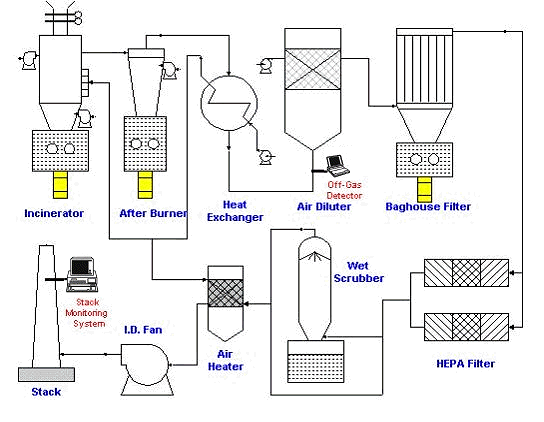
Fig. 1. Schematic diagram of
demonstration-scale incinerator.
INCINERATION PROCEDURES
Waste Characterization
The combustible wastes burned in this work were sampled from the extremely low level RI wastes that had passed more than 2 years since their generation. The radioactive nuclides in the RI waste were iodine-125 (of about 70%), technetium-99m (of about 10%); phosphorous-32, tritium or carbon-14, and the total activity was lower than 100 Bq/g. Their physical types were tubes, syringes, vials, bottles, and pipette tips. The results of the proximate analysis and the calorific values are shown in Table III. Most RI wastes were composed of volatile materials with little ash (less than 1%), and an average calorific value of them is about 37,000 kJ/kg (8,900 kcal/kg).
Table III Proximate analyses of RI wastes
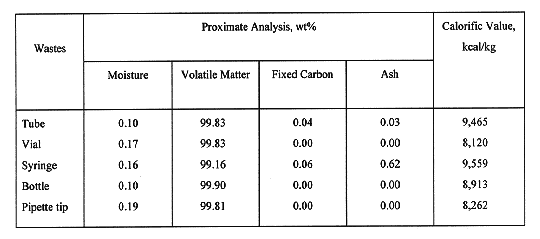
Estimation of Radiological Emissions
Before the incineration of RI waste, the radioactive release from stack emission to the ambient air was estimated for each radioactive nuclide. The most conservative method, assuming that the decontamination factor (DF) of incinerator and off-gas treatment system is 1, was applied to this estimation because the RI waste contained semivolatile nuclides such as radioiodine, radiocarbon, or tritium. The results are shown in TABLE IV. The activity of iodine-125 at stack emission was calculated to reach a half of the maximum permissible concentration (MPC) value established in regulation (13).
Table IV Estimation of Radiological Emissions in Incineration of RI
Wastes
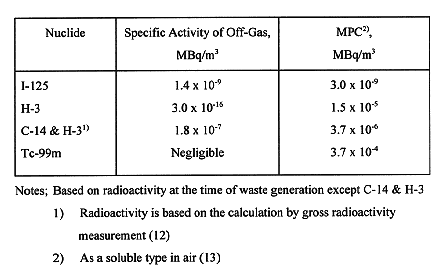
Incineration
The RI wastes unpacked from 100-liter drum were divided into the suitable quantity to be fed easily into the incineration chamber through the double sliding gate valve. Such small packages, of 1.8 liters and 3.3 kg on the average, were wrapped with a polyethylene sheet and put into paper bags. The trial incineration procedure was as follows: the incinerator was preheated up to 450°C using a gas burner alone, then up to a desired temperature, namely, the "incineration temperature" of 900°C, while feeding the inactive simulated wastes. After the temperature of the incineration chamber reached this temperature, the RI waste packages were fed. The preheating burner was turned off after feeding one or two packages. The waste was fed at a fixed temperature, i.e., 900°C, to maintain a constant incineration temperature. Since there was no chloride component in RI waste, the wet scrubbing system was not operated in this trial incineration. The off-gas stream passes through the dry off-gas treatment system consisting of a heat exchanger, a direct air mixer, a baghouse filter and a HEAP filter in series. During the trial-burns, the release of radioactive iodine and tritium at stack emission to ambient air were continuously monitored using a Bai 9103 Iodine Monitor (Berthold) and a Tritium Monitor LB-110 (Berthold) connected to a Multi-logger LB-5310 (Berthold). The specific activities of ashes from the incinerator, the afterburning chamber and the baghouse filter system were measured using a radioactivity measuring system (LB761 GD, Berthold) connected a Multi-logger LB-5310 (Berthold).
Active simulated waste with an RI tracer was also incinerated to study the behavior in this process. The I131 labeled sodium iodide of 74 MBq (2 mCi) was dissolved into demineralized and distilled water, and then evenly injected using a syringe into 12 waste packages.
RESULTS AND DISCUSSION
Incineration of Radioactive Wastes from Radioisotope Users
A typical temperature profile of incinerator operated at 900°C is shown in Fig. 2. This figure also shows that of an afterburning chamber when the afterburner did not operate. According to schedule to evaluate the effect of afterburner on the incineration performance, the first trial burn was carried out without operation of afterburner. However, only total 180 liters of RI waste could be incinerated in this work because the melted waste put into a space between the ash-withdrawal door and the incinerator bottom, which finally made the ash-withdrawal door not-operated. The ash-withdrawal door system is a hatch type which was originally designed to give the effectiveness in sealing and ash-removal when burning the NPP's wastes, composed mainly of paper, textile cloths, or shoes (7). To solve this problem, new burner for the melted waste on the bottom has been added close by the incinerator bottom.
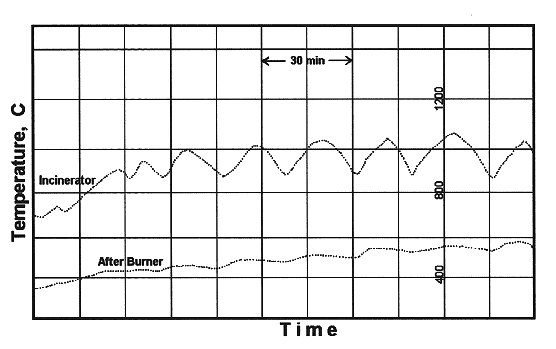
Fig. 2. Typical temperature profiles
for incineration of RI wastes, of no operation of afterburner.
A waste package was fed at every moment that the incinerator temperature reaches the incineration temperature. The temperature profile shows a sine curve with an average combustion temperature of 970°C, a fluctuation height of 150°C, and a width of 22 minutes. The incineration capacity calculated from a feeding interval of waste is 10.5 kg/h, equivalent to a thermal capacity of 390 MJ/h, which is lower than the design value of 420 MJ/h. The volume and weight reduction ratios calculated from the total amount of ashes from the incinerator, the afterburning chamber and the baghouse filter system shows the maximum values of 250 and 30, respectively. Volume reduction factor is almost twice as high as that of wastes generated from NPP (11). Such high values was obtained only the case of the trial burns of waste composed of a single component such as paper, textile or polyethylene sheet (8,9), which seems to be caused by an uniformity of waste. The volume reduction ratio is very high, compared to the weight reduction ratio, which comes from the fact that the combustible RI wastes are mainly composed of plastic materials with large void volume and are packed with no pressure. During the incineration, the observed concentrations of concerned components such as CO, SO2, HCl, HF, NOx, or CO2, in the effluent gas stream were lower than the regulatory limits. The radioactivity of radioiodine and tritium at stack emission, which were continuously monitored during all the trial burn of RI wastes, were under 0.5 Bq/m3, and under the background value, respectively.
Incineration of Simulated Wastes with Radioiodine (I131) Tracer
The previous trial run of RI waste showed that the activity of radioiodine in RI waste was too low to be detected at stack emission. Since the generation of RI waste to fill up the 100-liter drum usually took some time and contained several nuclides, it was very difficult to sample a representative RI waste and to measure its actual activity. Therefore, the simulated waste with I131 of total 74 MBq was incinerated at the same condition as the incineration of RI waste. For all steps in incineration and until the next day, the activity of radioiodine at stack emission was measured every minute, and the measured values were grouped according to each incineration step. An average radioactivity release at stack emission, calculated from the difference between the values averaged during a preheating step and an incineration step, was 2.51 x 10-2 Bq/m3. The system decontamination factor (DF) is defined as the ratio of the radioactivity in feed waste to the radioactivity released at stack. The DF calculated by taking account of the flow rate of off-gas stream and operation time was about 1.7 x 105. This result is very similar to our previous results, 4.7 x 105 for Co-60, 6.2 x 105 for Mn-54, 2.6 x 104 for Cs-137, and 1.1 x 105 for NPP's wastes, which were obtained by sampling with an isokinetic particulate sampling train, calculating each DF for three system such as incinerator, baghouse filter or HEAP filter, and then multiplying of them (11).
After the incineration, the specific activities of ashes from incinerator, afterburning chamber and baghouse filter system were measured, and the results are shown in TABLE V. The specific activities of the ashes from baghouse filter system and afterburning chamber were shown 370 and 24, respectively, times as high as that of the incinerator bottom ash.
Table V Specific Activity of Ash After Incineration of a Simulated
Waste with Iodine-131

Such results can be explained as follows: At the incineration temperature above 900°C, the major portion of radioiodine melts or vaporizes and gets away from the incineration chamber. As the temperature of the off-gas stream goes down, the melted or vaporized radioiodine is condensed out of the gas stream. The I131 used as a tracer existed as a sodium iodide with a melting point of 651°C. The typical temperatures of the afterburning chamber and baghouse filter system are about 520 and 120°C when the afterburner is not operated. Some quantity of the condensed iodine is collected by the cyclone-type afterburner system with a function of dust-collection. As the temperature of off-gas stream decreases further while passing through a heat exchanger and a direct air mixer, the condensation of vaporized iodine increases, therefore, much more radioiodine is collected at the baghouse filter system. As a result, the activity of ash from a baghouse filter system is much higher than the others. A more detailed, quantitative analysis on the amount of radioiodine captured at each unit process is needed to characterize the behavior of radioiodine, and it will be performed soon.
CONCLUSION
The trial burns for the LLW produced from radioisotope users and an active simulated waste with radioiodine were performed in a demonstration-scale incinerator. The incineration of the RI wastes showed a high volume reduction factor and no detectable radioactivity at stack emission. The incineration of a simulated waste with a I131 labeled sodium iodide of 74 MBq showed that the specific activities of ashes from the baghouse filter system and afterburning chamber were much higher than that of incinerator bottom ash, which means that most radioiodine vaporizes and gets away from the incineration chamber, therefore, very little radioiodine remains in the ash. These results suggest that special consideration, such as the addition of a condensing system to the off-gas treatment system, or a content limitation of volatile nuclides in the feedstream, is needed for the incineration of RI wastes.
REFERENCES